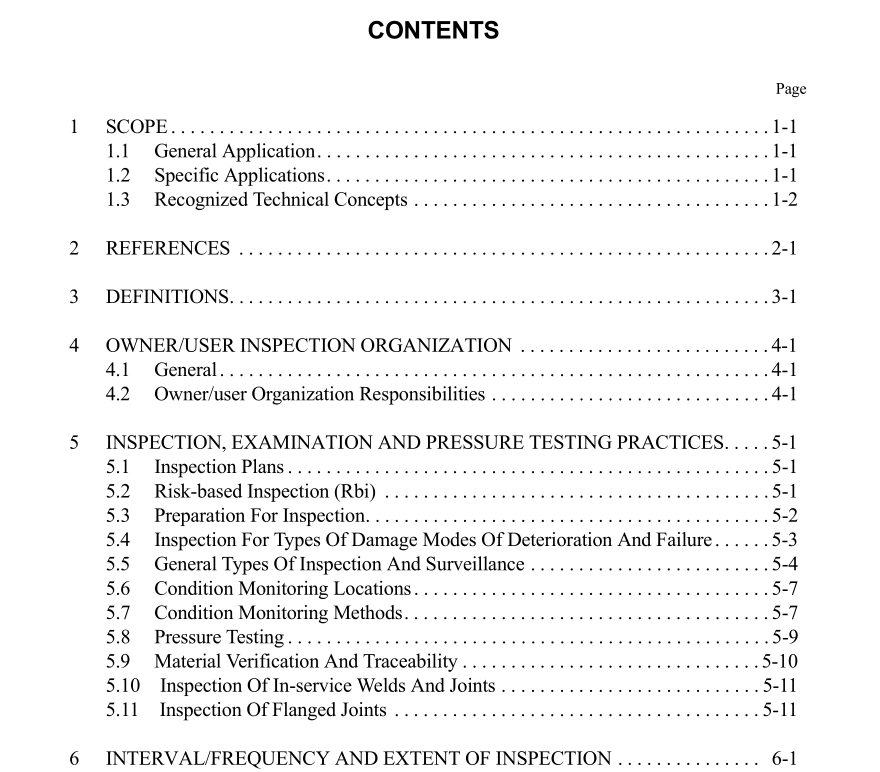API 510 pdf download

API 510 pdf download.Pressure Vessel Inspection Code: In-Service Inspection, Rating, Repair, and Alteration
1.1.1 Coverage
This inspection code covers the in-service inspection, repair, alteration, and rerating activities for pressure vessels and the pres- sure-relieving devices protecting these vessels. This inspection code applies to all refining and chemical process vessels that have been placed in service unless specifically excluded per 1.2.2. This includes: a. vessels constructed in accordance with an applicable construction code b. vessels constructed without a construction code (non-code)—A vessel not fabricated to a recognized construction code and meeting no known recognized standard c. vessels constructed and approved as jurisdictional special based upon jurisdiction acceptance of particular design, fabrication, inspection, testing, and installation d. non-standard vessels—A vessel fabricated to a recognized construction code but has lost it’s nameplate or stamping. The ASME Code and other construction codes are written for new construction; however, most of the technical requirements for design, welding, NDE, and materials can be applied to the inspection, rerating, repair, and alteration of in-service pressure vessels. If an item cannot follow the ASME Code because of its new construction orientation, requirements for design, material, fabrica- tion, and inspection shall conform to API 510 rather than to the ASME Code. If in-service vessels are covered by requirements in the ASME Code and API 510 or if there is a conflict between the two codes, the requirements of API 510 shall take precedence. As an example of the intent of API 510, the phrase “applicable requirements of the ASME Code” has been used in API 510 instead of the phrase “in accordance with the ASME Code.”
1.1.2 Intent
The application of this inspection code is restricted to owner/users that employ or have access to the following technically quali- fied individuals and organizations: a. An authorized inspection agency; b. A repair organization; c. An engineer; d. An inspector; and, e. Examiners. Inspectors are to be certified as stated in this inspection code (see Appendix B). Since other codes covering specific industries and general service applications already exist (e.g. NB-23), the refining and petrochemical industry has developed this inspection code to fulfill their own specific requirements for vessels and pressure-relieving devices that fit within the restrictions listed in the scope.
3.2 alteration: A physical change in any component that has design implications that affect the pressure-containing capability of a pressure vessel beyond the scope described in existing data reports. The following should not be considered alterations: any comparable or duplicate replacement, the addition of any reinforced nozzle less than or equal to the size of existing reinforced nozzles, and the addition of nozzles not requiring reinforcement. 3.3 applicable construction code: The code, code section, or other recognized and generally accepted engineering stan- dard or practice to which the pressure vessel was built or which is deemed by the owner/user or the engineer to be most appropri- ate for the situation. 3.4 ASME code: refers to the ASME Boiler and Pressure Vessel Code including its addenda and code cases. 3.5 authorization: Approval/agreement to perform a specific activity (e.g. repair) prior to the activity being performed. 3.6 authorized inspection agency: Any one of the following: a. The inspection organization of the jurisdiction in which the pressure vessel is used. b. The inspection organization of an insurance company that is licensed or registered to write and does write pressure vessel insurance; c. The inspection organization of an owner or user of pressure vessels who maintains an inspection organization for his equip- ment only and not for vessels intended for sale or resale; or d. An independent organization or individual that is under contract to and under the direction of an owner/user and that is recog- nized or otherwise not prohibited by the jurisdiction in which the pressure vessel is used. The owner/user’s inspection program shall provide the controls that are necessary when contract inspectors are used.









